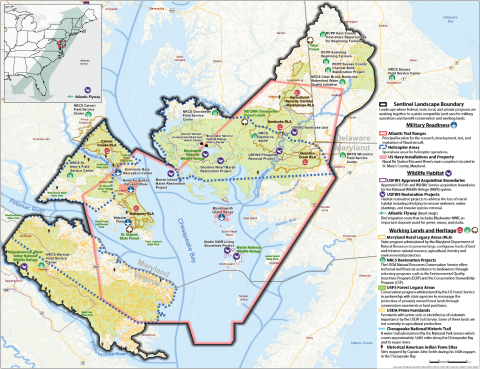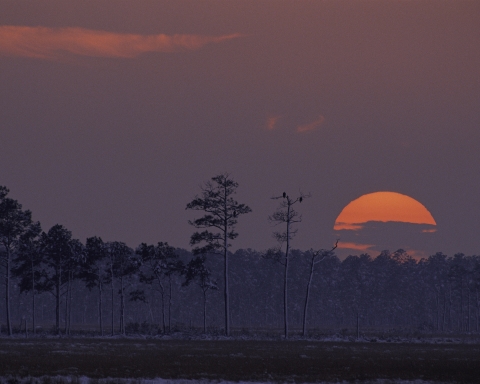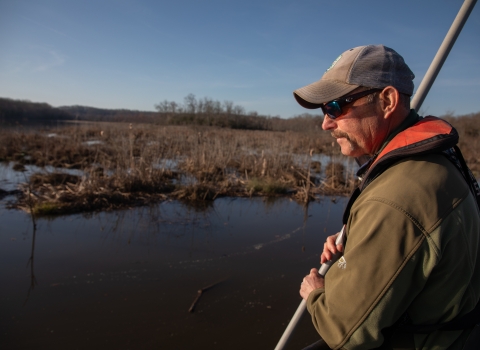In a place where a short fall hike might reveal a couple dozen species of waterfowl, a few Delmarva fox squirrels, and a stand of rare Atlantic white cedar, everyday bustle and the ticking of the clock can quickly disappear.
Neither the bustle nor the clock is as far away as it seems, though.
Many who are invested in the future of what’s been called “the Everglades of the North” — and includes the U.S. Fish and Wildlife Service’s Blackwater National Wildlife Refuge — are eyeing both as they work to keep a space for nature, to benefit all who depend upon it in one way or another.
“I think we’re making progress,” said Joel Dunn, president and CEO of the Chesapeake Conservancy, a nonprofit protecting landscapes throughout the greater 41-million-acre Chesapeake Bay watershed. “But we have a race against time.”
Mounting challenges
The landscape around the Delmarva Peninsula’s Nanticoke and Blackwater rivers, and Fishing Bay, contains some of the Eastern United States’ most pristine and productive wetlands.
They’re an important stopover and breeding ground for millions of waterfowl, waterbirds, and migratory birds. They also provide habitat for other priority species, including the highly vulnerable saltmarsh sparrow, eastern black rail, Delmarva fox squirrel, and Atlantic and shortnose sturgeon.
Still, major challenges loom. One is development: Across Chesapeake Bay, the Washington, Baltimore, and Philadelphia metro areas boast a combined population of more than 15 million — and counting.
Another is climate change climate change
Climate change includes both global warming driven by human-induced emissions of greenhouse gases and the resulting large-scale shifts in weather patterns. Though there have been previous periods of climatic change, since the mid-20th century humans have had an unprecedented impact on Earth's climate system and caused change on a global scale.
Learn more about climate change : In the peninsula’s wetland landscape, thousands of acres have been lost to rising seas, and the prognosis is worrisome. By 2050, 50% of the lower Eastern Shore’s high marshes — on which the saltmarsh sparrow and Eastern black rail rely — are expected to disappear.
Cautious optimism
Much work has been done by a remarkable constellation of partners. In recent years, a powerful concept called a “Sentinel Landscape” is also helping meet these challenges.
“About 33% of the Nanticoke-Blackwater landscape has been protected,” Dunn said. “It’s become what I would argue is the premier example on the East Coast of the president’s goal for land and water conservation.”
“We’ve been super-lucky to have so many partners doing really terrific work out there. We’re striving to work smarter together — to leverage our networks and resources and knowledge to enhance our collective ability to achieve our goals,” he said.
Case in point: the roughly 2.2-million-acre Middle Chesapeake Sentinel Landscape
The U.S. Departments of Agriculture, Defense, and the Interior developed the Sentinel Landscapes Partnership to help protect natural and working lands near defense facilities from land use that is incompatible with the military’s mission.
The Middle Chesapeake Sentinel Landscape was established in 2015 and envelops the Nanticoke, Blackwater, and Fishing Bay wetlands in its three-state footprint. Its objective is to promote base resilience and avoid development that could trigger flight restrictions at the U.S. Navy’s premier aircraft testing location, Naval Air Station Patuxent River, and the associated Atlantic Test Ranges.
The Sentinel Landscape is one of many conservation-focused collaborations in the area that bring together public agencies at every level, nonprofits large and small, private foundations, community advocates, and businesses to make significant gains.
Powerful partnerships
Two recently awarded grants in the Nanticoke-Blackwater-Fishing Bay landscape highlight how the Sentinel Landscape and some of the Chesapeake Bay watershed’s conservation-focused partnerships work.
The grants — a $3-million Department of Defense Readiness and Environmental Protection Integration (REPI) Challenge grant and a $1.5-million North American Wetlands Conservation Act grant — were awarded in 2020 and this fall.
Combined, they’re being used to protect about 4,000 acres in a designated marsh migration corridor — where marsh habitat can move as rising seas push it inland — on Maryland’s Eastern Shore.
An array of partners — including the U.S. Navy, the U.S. Fish and Wildlife Service, The Nature Conservancy in Maryland/DC, Eastern Shore Land Conservancy, The Conservation Fund, and Ducks Unlimited — worked to secure these competitive grants.
While habitat protection is also done through land acquisition, the work associated with these grants will happen with voluntary conservation easements that protect property for the long-term while allowing some traditional uses.
“In a lot of cases, landowners want to continue to maintain ownership over their property and continue their existing practices; maybe that’s keeping it as an area for hunting or agriculture,” said Melanie McGinnes, an environmental scientist and civilian employee of the Department of the Navy who works with the Sentinel Landscape. “We’re happy when we’re able to step in and support that through conservation easements that also support our mission.”
Strategic choices
Even with significant successes and an impressive array of partners at work, resources for conserving Eastern Shore wetlands are limited so making good choices about where to focus is important.
Because of the Delmarva Peninsula’s tremendous habitat value, land protection itself provides significant benefits for wildlife. But sometimes it’s not enough. Conversion of marsh habitat to open water is one of the most significant ecological threats in the region.
Between 1938 and 2006, Blackwater National Wildlife Refuge alone lost more than 5,000 acres of marsh, due in great part to voracious nutria. The big, invasive rodents chewed their way through plants that stabilized the marshes, making them more susceptible to sea-level rise and erosion. Thanks to management by the Service and partners, nutria have been largely eliminated from the landscape.
Realities like this led The Nature Conservancy to spend a year analyzing the best available conservation science and sophisticated landscape data to find marshes that have the greatest chance of being resilient to climate change impacts.
“We identified the coastal sites that are most likely to support tidal wetland habitat adaptation in the one- to six-foot sea-level rise scenarios,” said Elizabeth Carter, the global conservation nonprofit’s Maryland/DC land protection director. “Now, we are working with partners and willing landowners to protect these prioritized salt marsh salt marsh
Salt marshes are found in tidal areas near the coast, where freshwater mixes with saltwater.
Learn more about salt marsh -migration corridors that provide critical habitat and a natural buffer against the effects of storms and floods.”
Novel approaches
This science and shoe-leather approach is helping partners in the Nanticoke-Blackwater landscape pursue projects with the greatest potential to deliver long-term impacts, said Dan Murphy, supervisory biologist at the Chesapeake Bay Field Office of the U.S. Fish and Wildlife Service.
“If development happens in upland migration zones adjacent to existing wetlands, these wetlands will have nowhere to go as sea level rises,” Murphy said.
“Not only would we lose the wetlands, but we would lose the things they provide — nurseries for fish, protection for physical infrastructure, habitat for rare birds like the saltmarsh sparrow and the black rail,” Murphy said. “That’s worst-case scenario for the Chesapeake.”
Murphy and other partners are quick to point out, though, that land protection, even with sustained successes, is only part of the solution. Another element is making existing marshes more resilient to rising seas and other impacts.
“We have species like the saltmarsh sparrow that need the habitat now,” Murphy said. “It’s estimated there are about 30,000 of them left. To maintain that species, we need to maintain the existing habitat.”
That’s why the Service and partners are exploring innovative restoration techniques such as filling in man-made ditches and adding sediment to the marsh surface — a process called thin-layer deposition — to improve tidal flow and raise marsh levels to reduce flooding.
Growing momentum
This is all music to the ears of Joanna Ogburn.
Although she was raised in Easton, Ogburn’s family, surname Bounds, settled along the Nanticoke River in the 1670s. Now, as principal of JBO Conservation, which coordinates the Middle Chesapeake Sentinel Landscape Partnership, she gets to work to protect it.
“It’s an area that’s near and dear to me,” Ogburn said. “The partners here have great alignment. It’s been incredible to be part of that as it’s grown.”
“There’s so much to do,” she said. “We’re just working hard together to see how we can ramp up all these protection efforts and get more and more folks on board.”
There’s no time to waste.










